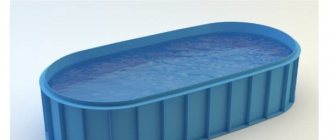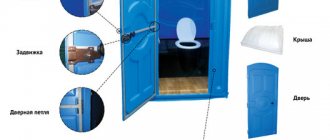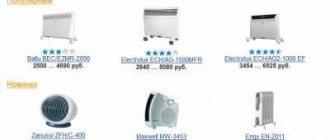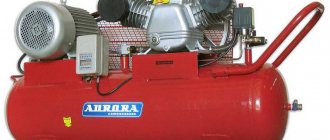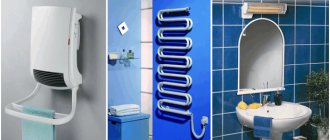Here you will learn:
- What is convection
- Advantages and disadvantages of convector heating
- Types of convectors
When planning to create heating in our home, we want it to be economical and efficient. Convector heating has precisely these characteristics - it is based on convectors powered by bottled or main gas, water systems or an electrical outlet. Let's see what convectors are, how they work and how they differ from each other. We will also look at the main features of convector heating of residential premises.
General description of the equipment
Radiators are a group of technical devices that are designed for primary or additional heating of a room due to effective heat transfer. The source can be a water circuit, liquefied or natural gas and the electrical network. Let's look at what a convection heater is and how it works.
Traditional units made of cast iron or with coolant oil release thermal energy through the housing. The walls can heat up to +95 degrees Celsius, which is unsafe for the user. The solution to this problem was the manufacture of radiators with perforations on top and slots on the bottom. This way the housing is cooled due to relatively cold air flows in the area. According to the laws of physics, they displace the warm environment that spreads throughout the room. The operating principle of a convector heater is based on this phenomenon.
Equipment is divided into 3 groups according to the type of heat source. Water ones are connected to a central or autonomous water supply and are a lighter and more aesthetic alternative to cast iron “accordions”. Electric works from the network. Here, heat transfer occurs due to the built-in heating element.
Electric radiator of convector type Source vodopad.ru
It is believed that the efficiency of this series of equipment is 100%.
Gas convectors are an economical and practical solution. But the installation is carried out taking into account the permanent installation, stretching of the pipeline, and arrangement of an outlet channel for fuel combustion products. Design and repair difficulties, final estimates for materials and specialist work, maintenance are the reasons for the low demand for equipment.
Simple models can be improved by connecting thermostats. Instead of slots and perforations, adjustable dampers – blinds – can be installed. Another solution is to cast the cracks not in a horizontal position, but with a slope towards the floor. Let's get acquainted with the device and criteria for choosing a convector heater for your home.
Convection principle
The principle of operation of a convector battery
The principle of convection used in heating systems is that when cold air enters the zone of thermal radiation, it absorbs energy and warms up. At the same time, the air becomes lighter and rises while simultaneously transferring heat to other objects. The lack of constant contact with the source leads to a gradual cooling of the upper air layers. Because of this, they become heavier, sink down and come back into contact with the equipment that radiates heat.
This cycle is continuous as long as thermal energy is transmitted by the source. The intensity of the convection process can be increased using specialized equipment. The use of convector heating batteries as part of the system allows you to create a powerful directed air flow. They operate with consistently high efficiency and have excellent energy efficiency indicators.
Radiator design
When choosing convector-type heating equipment, you need to consider the intended heat source. Depending on this, the design of the units differs, which is reflected in the requirements for installation work. Let's take a closer look at each series.
Gas
A sealed closed chamber and a burner are built into the body of such equipment.
Gas type convection radiator with a closed chamber Source kotlotorg.ru
Oxygen access is ensured in the section where fuel combustion occurs. To do this, a relatively wide channel with a windproof lining in the form of a lattice is brought outside. There is also a pipe for connecting the outlet of combustion products of gas fuel to the outside of the building. It is inserted inside the supply pipe. Such a system is otherwise called coaxial.
There are models with an open gas combustion compartment. This is a positive introduction regarding the decorative component. However, in this case, partial air intake occurs and it is saturated with carbon dioxide inside the heated room.
When choosing a unit, it is necessary to take into account the type of combustible fuel:
- natural gas - according to GOST it must meet low pressure (1274 MPa);
- liquefied - a gearbox and a nozzle are provided for connection, and a control unit is provided for adjustment.
When considering samples for long-term use, you should prefer radiators with a chamber cast from cast iron. It retains heat longer and only cracks due to sudden cooling or heating. This is also justified by the fact that even heat-resistant steel burns out over time. On the other hand, equipment with steel compartments weighs 10-15 kg less.
Model of a gas convector with a cast iron chamber Source 35.teplozhar.ru
The heat exchanger is typically designed in area to operate at temperatures ranging from +60 to +120 degrees Celsius. Heating occurs quickly and evenly. Actual heating can reach +600 degrees, but in household models this is excluded.
Before making a decision, you need to familiarize yourself with some features of the heater:
- high heating of the heat exchanger provokes the disintegration of dust particles, so regular ventilation of the heated room is necessary;
- there is a noticeable temperature difference in the area of the equipment and at a distance from it;
- to ensure the flow of oxygen and the removal of gas combustion products, access to the street is required, which forces the owner to form a through hole in the wall;
- if the supporting structure is made of flammable material, then additional insulation of the channel with a fire-resistant sealant will be required;
- It is recommended to install a coaxial pipe in the area of the window opening for better ventilation (the distance from the slope is kept at least 30 cm, from the floor - more than 15 cm);
Traditional radiator location Source mr-build.ru
- the gas pipeline system is laid in strict accordance with fire safety requirements;
- Before starting heating equipment, an assessment by a specialist is required to ensure the correctness and serviceability of the system (in the case of a central gas supply, permission to connect a radiator is also required).
The advantages of a gas heater include efficiency. This applies to the cost of the power supply. Also, a pair of convectors is cheaper than installing a boiler with the same fuel. Warming up the room is done quickly, since heat transfer from the combustion chamber begins almost immediately.
See also: Catalog of companies that specialize in home insulation
Water
Structurally, the convector for heating is represented by a copper pipe for the coolant and aluminum fins made of plates as a heat exchanger. For connection to a central or autonomous water supply system, pipes with threaded fittings are provided. To prevent air accumulation in the radiator, there is an air valve.
Convection radiator in water coolant Source mircli.ru
The housing is often made of thin sheet steel that is resistant to temperature changes. Powder paint is applied to the front side of the back panel by spraying. To ensure convection, there are slots at the bottom or there is no platform at all; there is perforation in the top cover.
Before making a decision, it is worth considering the following features of the operation of a water convector:
- copper and aluminum conduct heat well, so the heat exchanger heats up and cools down equally quickly (this affects the overall environment in the room);
- For efficiency, heating equipment is often made in a relatively larger size than conventional radiators;
- the heat exchanger is represented by many plates, on which a lot of dust, dirt and animal hair settles, which must be constantly removed (it is not recommended to install such a radiator in a house with allergies).
Water convector with copper fins Source konveyt.ru
The advantages of a water convector heater for the home are enough to be in great demand in the private sector. This equipment is permissible for installation in an apartment, house or country house without obtaining official permission. Unlike traditional radiators, efficiency is observed here even at low coolant temperatures. The total weight of the unit is low due to the lightness of copper, aluminum and steel. Weight is largely influenced by the volume of coolant. But in most cases, mounted radiators can be mounted on plasterboard walls.
Electric
The main difference between an electric convector heating system and its analogues is the absence of a sealed fuel combustion chamber or pipeline. Here, a compact heating element is located inside the hollow body. It converts electric current into thermal energy.
Electric convector design Source termo-volga.ru
Based on this, the main advantages of the convector are:
- instant air heating;
- low weight of the structure;
- there is no channel system for coolant, oxygen or smoke exhaust.
The narrow box has the following features:
- Material. Aluminum or thin sheet steel is used to make the body. Corrosion protection is provided on the inside, and powder paint is additionally applied on the outside.
- Top and bottom end. There are slots, perforations or blinds. The last option can be adjustable.
- Back wall. There are plates soldered on it for hanging the radiator on response brackets or hooks.
To figure out which electric heating convectors are best for a private home, you need to consider the features of built-in heating elements. The table shows the characteristics of each of the possible heating elements.
| Heating element type | Description | Technical features |
| Stitch | In Russia the accepted name is needle-shaped. Consists of a dielectric plate and an incandescent filament. The conductive element is made of a nickel-chromium alloy and has an insulating coating with heat-resistant varnish. This ensures the core is protected from direct contact with oxygen. The wire is attached to the base in the form of many loops on both sides. | The tape is heated within a few seconds to +250 degrees Celsius. It takes the same amount of time to cool down. The radiator operates silently. Consumes relatively little energy. |
| Tubular | The element is made in the shape of a flask. Material: high-strength steel. The cavity is filled with quartz, ceramic or magnesium sand of fine fraction. In order to increase efficiency, aluminum plate or spiral elements are attached to the flask. The technical design of fins varies among manufacturers, but the heat transfer is almost identical. The heat source is a filament built into the flask. | Since the filament is isolated from oxygen, its service life is extended by 1.5-2 times (against the background of a needle heating element). The degree of protection of the heating element can be equal to IP24, which allows you to install the radiator in a damp room, but away from splashes (0.6-1 m). Full heat transfer begins after a few minutes. |
| Monolithic | This is a one-piece design with a filament inside. Here the sealed flask is made of silumin alloy (based on aluminum and silicon). The filler is often quartz sand. The fins here are fixed on four sides and have an X-shape. | It is considered the most effective and protected from moisture. Heat loss is minimized due to tightness and fins. It does not affect the state of the surrounding air. Expensive, but can be used in almost any room. |
Household-type heating elements are characterized by power from 0.3 to 6 kW. To replace the heating element, pay attention to its length. It is recommended to consider a size 10 cm smaller than the heater body. Also, the passport must contain a list of radiators for which one or another heating element is applicable.
Gas heating
Things are not much better with gas heating. The costs of its construction are comparable to the costs of organizing electric heating (with an electric boiler and liquid coolant).
But if you are “lucky” to purchase a plot that is located in an area with poorly developed engineering infrastructure, add to the total costs the costs of connecting a gas pipeline to your home (the cost of gas pipelines, the cost of developing design documentation and other inevitable expenses). For the Moscow region this is:
- costs for design and approval of project documentation with its subsequent registration - 20 thousand rubles;
- installation of gas pipelines - from 3 to 50 thousand rubles);
- tie-in into the gas supply pipeline – 30 thousand rubles;
- commissioning of a gasified facility with the participation of supervisory and control organizations - 50 thousand rubles.
To this should be added the cost of obtaining the necessary permits, approvals and technical conditions (which, by the way, are also needed when building a classic heating system with an electric boiler). In the end, this is plus another 50...100 thousand rubles (according to the most conservative estimates).
Total: 149 thousand rubles. (heating installation) plus 250 thousand rubles. (gasification of the site). We receive a “tidy” sum, which is close to 400 thousand rubles.
There is no doubt that if a person managed to buy a house already gasified, then he was really lucky. Indeed, in cold weather, the average bill for gas heating in the Moscow region in the winter of 2021 ranged from 6 to 8 thousand rubles. (we are talking about houses with an area of 100 m²).
Equipment selection criteria
To determine which convector is best installed in a particular room (electric, water, gas), you need to consider the operating conditions and installation of the radiator. The power and dimensions of the equipment are also taken into account. Let's consider the selection criteria in more detail.
Installation
There are two main types of radiators: stationary and mobile. The first ones are installed in the designed position without the possibility of movement. These are all water and gas radiators, some electric. This group includes heaters for hanging, built into walls or floors. Equipment with a network connection can be classified as mobile; the main thing is to place the cable safely.
Mobile model of a heating convector Source ventoprofi.ru
Installation features
Water convectors
Installation and operation of heating equipment directly depends on the type and operating principle of the installed devices. When connecting a water radiator-convector, it is necessary to take into account the characteristics of the material from which it is made. The equipment is mounted on the wall using brackets. Special pipes are used to connect to the heating system and supply coolant. For joining, you can use steel or plastic pipes.
Installation of electrical equipment is much simpler and does not require the participation of specialists. Before installation, it is enough to take into account some safety rules. The distance to the floor should be more than 20 cm, to the outlet - from 35 cm, from the ceiling - from 55 cm, from the wall - less than 25 cm.
Self-installation is not permitted for gas units. Even a detailed study of information on specialized sites does not allow you to avoid errors, which is unacceptable from a security point of view.
Video description
In this video, the master talks about the difficulties and problems that can be encountered when installing a water convector with water heating:
terms of Use
For dry rooms, you can choose any convector heater. For a kitchen or bathroom, it is necessary to consider the degree of protection of the heating element and control unit in the case of electrical equipment. In addition, it is necessary to take into account the heating temperature of the housing in order to prevent the occurrence of burns or fire of surrounding objects and decorative trim.
The second point can be eliminated using devices that are equipped with an automatic overheating sensor. It turns the equipment off and on when the set temperature thresholds are reached. Another solution is to install a thermostat. This device allows you to independently adjust the heat output of a convection heater.
Convector with thermostat Source elektro-teh.com
Power and efficiency
For a temperate climate in Soviet times, calculations were made. As a result, even today it is believed that 1 kW of energy must be taken into account per 10 square meters of area. It is worth noting that such a guideline is relevant for a house in which there is practically no heat loss; the ceiling height is limited to 2.7 meters. That is, for constant convector heating of dilapidated housing or with high ceilings, you need to increase the power. The additional heat source can be selected with a lower value relative to the reference.
The efficiency of radiators depends not only on the design of the basic components and its power. Additionally, the unit can be equipped with a fan. It provides forced movement of heated air, which speeds up the process of warming the space in the room.
Types of systems using convectors
A heating system based on the convection principle can be:
- water - using convection radiators, pipes and an electric, gas, solid fuel or liquid boiler;
- electric – implies the installation of electric convectors;
- gas - in this case, gas convectors are installed in the premises, which usually operate from bottled gas.
All of the above heat supply systems have distinctive characteristics.
The main requirement for operation
The principle of operation of a convector for heating a private house or apartment is the passage of air flow through the equipment body. This phenomenon eliminates the possibility of covering the radiator with anything for the purpose of warming or drying. If you block the perforations or slots in the upper end of the box, the heated air will not be able to spread with proper efficiency. In the case of a convector-type electric heater, humidity can be a detrimental factor for the heating element or a person. This is justified by the fact that water is an excellent conductor of current.
Installation in a private house
The ease of installation of electric convectors allows you to implement this procedure yourself.
Before you make convector heating with your own hands, you need to prepare the following tools:
- Hammer.
- Screwdriver.
- Hammer.
- Level.
A wall-mounted electric convector is installed in the following sequence of operations:
- Assembling the device, during which it is necessary to secure all the brackets to the body.
- Fitting the structure to the wall surface: it must be leveled. During this, marks are made at the location of the brackets.
- The brackets must be removed from the panel and attached one by one to the applied markings. This makes it possible to mark points for drilling holes for fasteners.
- Using a hammer drill, holes are made in the marked places.
- Using a hammer, carefully hammer the dowels into the base.
- To screw the brackets, use a screwdriver or screwdriver.
- The instrument panel is hung on well-fixed brackets.
- To start operating the convector, it must be connected to the network.
When using electrical appliances, it is important to understand that such convector heating of the house will significantly increase the load on the network, so you should calculate in advance whether the old wiring will withstand this. To ensure heating safety, it is recommended to equip devices of this type with separate cable lines. https://www.youtube.com/embed/WZnvggq6oWI
Briefly about the main thing
A convection heater works by heating the cold air flow that enters the floor area.
According to the heat source, gas, water or electric equipment is distinguished.
A gas heater can have cast iron or steel combustion chambers installed.
Three types of heating elements are installed in an electric convector: monolithic, tubular or needle.
Criteria for choosing radiators: power, installation method, dimensions, operating conditions.
Ratings 0
Comparative table of technical characteristics of oil and covector heaters
| Options | Oil heater | Convector heater |
| Economical | - Low economical. | +Approximately 25% more economical. |
| Heating time | + - Conventional models heat up for a long time, but those equipped with fans quickly. | —Heats the room for a long time. |
| Comfort to use | -Average. | +Both floor and wall models are more convenient. |
| Safety | —High surface temperature (but there are models with a protective casing); If the operating rules are violated, there is a risk of explosion. | +The surface of the convector is not subjected to strong heating; can be left unattended. |
| Life time | -Average | +Big |
| Environmental friendliness | —Due to convection, it raises dust particles | —Due to convection, it raises dust particles |
And based on the totality of all this, when deciding whether to choose a convector or an oil heater, you can clearly conclude: of course, a convector. Lightweight, compact, silent and safe, these heating devices are gradually replacing heavy, short-lived devices filled with hot oil from apartments and offices. So we can say that oil heaters have almost become a thing of the past in the matter of heating rooms. The only thing is that models of oil heaters equipped with fans are able to heat the room somewhat faster, but the process of heating its surface itself remains long. See below for detailed materials on choosing these heaters.
(no votes yet)
Review of manufacturers
A convector battery, the price of which depends on many factors, can cost in the range from 2 to 20 thousand rubles. The simplest types of electric batteries have a minimal set of functions. Their cost is from 2 thousand rubles. But among the variety of models presented, experts advise choosing electric convectors with TEN or monoblock. Devices from the Electrolux, Polaris, and Ensto brands have proven themselves well.
A gas convector will cost more. Its cost is from 13 thousand rubles. The most famous manufacturers of this type of equipment are Karma, ATON, Gorenje. Reviews about these manufacturers are more positive.
It should also be noted that the cost of the convector depends on the principle of its installation. Floor and wall models will cost much less than built-in equipment.
What additional options do convectors have?
Some extras functions can really be useful. And if the device has them, then it is better to choose it than a more primitive device. For example, a temperature controller. This is very convenient, if it’s warm outside, turn it up a little, and if it’s frosty, set it to maximum.
When purchasing an electric heater, you must carefully study all the intricacies of the placement of the device, its features, as well as other factors that influence the choice of a particular model.
Many models are equipped with a timer, this helps to turn on the heater for the right time, and then the device will turn off itself. It is convenient to do this before bed.
If the device has a built-in ionizer, it absorbs dust well, and the air is saturated with negative ions. It's good for health. It is believed that one can sleep better in such a room and work more comfortably. Well, if the heater is equipped with a remote control, then controlling it becomes more than convenient. And, of course, it is important that the heater has protection against tipping over - this will protect children and animals from injury.
Types of heating elements
A convection heater uses the natural upward movement of warm air. To increase its temperature, a heating element is needed. Its peculiarity is its large surface in contact with air. This is achieved in different ways, which is why heaters for convectors are produced in different versions.
The types of elements are not too numerous:
- needle;
- tubular (TEN);
- monolithic;
- ENGLU, or tape.
All types of heaters have advantages and disadvantages, so when choosing a device for heating rooms, you should pay attention to the type of element installed in it.


